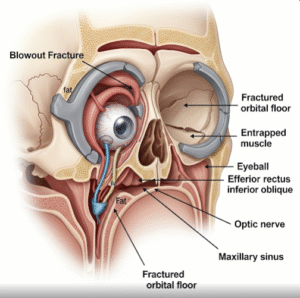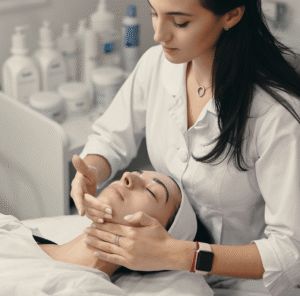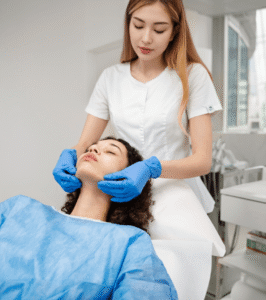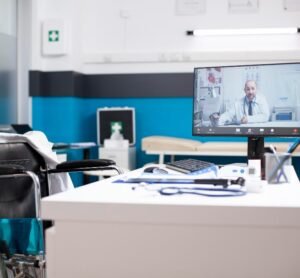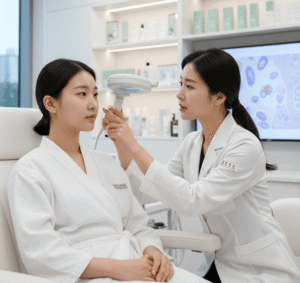What It Is
A reverse abdominoplasty is a type of tummy tuck that removes excess skin and tightens the upper abdomen, just below the breasts or chest. Unlike traditional abdominoplasty, which addresses the lower belly, the reverse approach involves incisions made along the lower edge of the breasts or in the breast crease, allowing the surgeon to pull skin upward rather than downward.
In Korea, reverse abdominoplasty is performed in specialized plastic surgery centers, often as a standalone procedure or in combination with breast surgery (augmentation, lift, or reduction) for comprehensive torso contouring.
Why It’s Done
This surgery is considered for patients who:
- Have significant loose skin or wrinkling in the upper abdomen.
- Experience sagging skin after weight loss, aging, or pregnancy.
- Desire improved contour in the upper stomach area when a standard tummy tuck is not appropriate.
- Want to combine abdominal tightening with breast procedures for overall torso rejuvenation.
It is especially beneficial for individuals who have excess skin above the belly button but relatively minimal issues in the lower abdomen.
Alternatives
Before choosing reverse abdominoplasty, patients may consider other options:
- Traditional abdominoplasty: Removes skin and tightens the lower abdomen.
- Mini-abdominoplasty: Focuses on smaller corrections below the belly button.
- Non-surgical tightening: Ultrasound or radiofrequency devices for mild skin laxity (less effective for significant sagging).
- Combination procedures: Breast surgery with standard tummy tuck, if both upper and lower abdomen need improvement.
Preparation
Preparation ensures safety and good results. Typical steps include:
- Consultation: Detailed assessment with a plastic surgeon to confirm candidacy and discuss surgical goals.
- Medical evaluation: Blood tests, imaging, and health review.
- Lifestyle adjustments: Avoiding smoking and alcohol for at least 2–4 weeks before surgery.
- Medication management: Temporarily stopping blood thinners or other drugs that increase bleeding risk.
- Recovery planning: Arranging time off work and assistance at home during the early recovery period.
How It’s Done
The procedure is performed under general anesthesia and generally lasts 2–4 hours. Key steps include:
- Incision: A horizontal cut is made along the breast crease or just beneath the breasts, often designed to blend with natural contours.
- Skin lifting: The surgeon lifts and removes excess upper abdominal skin.
- Tightening: The remaining skin is pulled upward for a smoother, firmer contour.
- Combination options: In some cases, the procedure is paired with breast surgery for comprehensive chest and abdominal improvement.
- Closure: Incisions are carefully closed with sutures, and dressings are applied.
Recovery
Recovery after reverse abdominoplasty is similar to other tummy tuck surgeries:
- First week: Swelling, tightness, and mild discomfort are common. Patients usually wear a compression garment for support.
- Mobility: Light walking is encouraged within a day or two, but strenuous activities should be avoided for 4–6 weeks.
- Follow-up care: Regular check-ups are scheduled to monitor healing and remove sutures if needed.
- Scarring: Incisions are hidden beneath the breast crease, fading over time with proper care.
- Final results: Improvements are noticeable within weeks, with full results visible after 3–6 months.
Possible Complications
As with any surgical procedure, risks include:
- Infection or bleeding.
- Delayed wound healing.
- Seroma (fluid accumulation under the skin).
- Numbness or temporary changes in skin sensation.
- Noticeable scarring (though usually concealed under the breasts).
- Rare risks such as blood clots or anesthesia-related complications.
Treatment Options in Korea
Diagnosis
- Detailed consultation with a board-certified surgeon.
- Body contour analysis and imaging to evaluate skin laxity in the upper abdomen.
Medical Treatments
- Pre- and post-operative medications for pain relief and infection prevention.
- Compression garments to support healing and optimize contour.
Surgical or Advanced Therapies
- Standard reverse abdominoplasty: Focused on removing skin from the upper abdomen.
- Combination surgeries: Often paired with breast augmentation, lift, or reduction for a balanced aesthetic.
- Hybrid approaches: Reverse abdominoplasty plus traditional tummy tuck for full abdominal reshaping.
Rehabilitation and Support
- Scar management therapies, including silicone sheets or laser treatments.
- Lymphatic drainage massage to reduce swelling and promote smooth healing.
- International patient services with translators, care coordinators, and virtual follow-up consultations.







